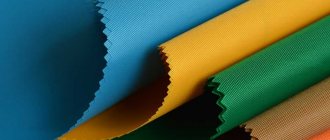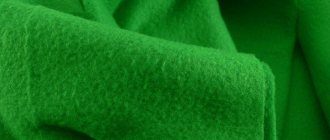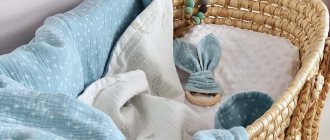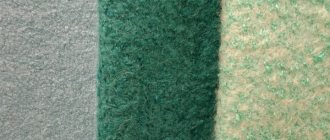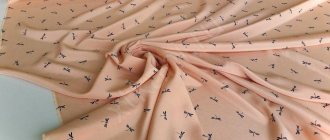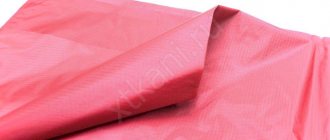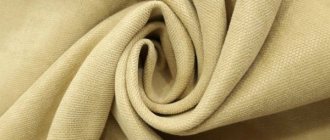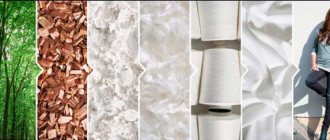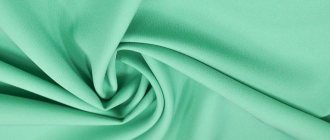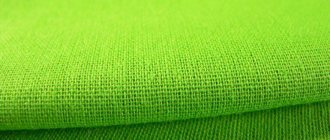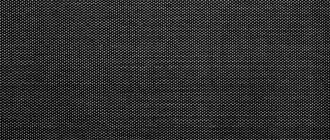Modern synthetic fabrics are solid competitors to natural materials. Synthetics are added to natural fibers to create new, sustainable types of fabric. One of the most popular representatives is nylon. In its pure form, nylon is used for the manufacture of outerwear and casual clothing, hosiery, military goods, items for hiking and sports.
Nylon has a very interesting history of creation, many positive properties and great practical possibilities. Easy care and low cost make the fabric invariably popular and affordable for any family. You can learn about the advantages and disadvantages of nylon from this article.
Origin story
Nylon was invented by Carothers in 1935, and in 1938 the fabric became in demand. It was typically used to make women's stockings, toothbrush bristles, and parachutes. In the post-war period, nylon was used to sew various clothes. It was perfect for the production of underwear, skirts, blouses, shirts, raincoats and various accessories.
Nylon colors
Where is nylon used?
The scope of application is quite wide.
In civilian use, it is found:
- In clothes. Polyamide admixtures or base can be found in a regular winter jacket, bag, sweatpants, etc.
- In the dishes. Its ability to hold its shape well and not crack from moisture and temperature allows it to be used to make dishes, including reusable ones and cutlery.
- In decor. Tablecloths, curtains, and decorative table covers are often made from polyamide.
It is also popular in the military industry for the production of uniforms and body armor, and in the tourism industry it is used to make camping clothing and awnings.
Advantages and disadvantages
Pros:
- Strength.
- Waterproof and stain resistant.
- Fast drying.
- Ability to stretch and quickly regain shape.
- Low price.
- High-quality protection from the cold.
- Variety and brightness of color.
- Easy to care for.
Minuses:
- Possibility of allergies (can be avoided if worn over other clothing).
- Poor air permeability.
- Unadapted to high temperatures.
- Poor reaction to moisture.
- Highly electrified (use of antistatic spray is recommended to avoid this problem).
- Does not withstand exposure to chlorine.
Rules for caring for things made of nylon
To maintain quality, you must adhere to the following rules:
- You need to wash in cold water - no more than 30 degrees. If this barrier is exceeded, it will begin to deform and turn into a rag.
- Do not use bleaches or aggressive powders.
- Any spin is suitable, both manual and machine.
- You need to dry on a horizontal surface, without sagging.
- Do not iron, at least through a damp thin cloth.
White clothes should be washed separately from colored ones, as they easily take on color. Since the surface of the fiber is smooth, any contamination quickly falls away.
approximate cost
Compared to natural fabrics, nylon has very low prices, but prices can vary greatly. On average, fabric can cost from 100 to 1000 rubles per meter in popular online stores. Nylon clothing can also be chosen to suit any budget - there are both very cheap models and high-quality items costing up to 20,000 rubles.
Despite the synthetic material, nylon clothing is suitable for daily use. The scope of application is very wide and extends to all spheres of society. This is facilitated by the practicality and beauty of the fabric.
Properties of nylon fabric
Nylon fabric is a completely artificial material that consists of adipic acid with the addition of hexamethylenediamine. These 2 components form a special salt, which, when dissolved with special compounds, produces a plastic called polyamide.
This is what nylon is in the broadest sense. Subsequently, it is heated, dye is added and thin threads are produced. The resulting composition has qualities that need to be considered.
Polyamide is a universal plastic, which is sufficient for the production of tableware, clothing, and travel equipment.
Waterproof
At the moment, polyamide plastic is produced by several companies, from which all nylon fabric is distributed under commercial names.
The most common are the following:
- Taslan Offman. It consists of thick nylon threads gathered into a durable fabric. Water does not even accumulate on it, but collects into drops and falls down.
- Complex Finetex. Durable polyamide, completely repels water and is not prone to getting wet. Often used for the production of tourist uniforms.
- Finetext. Strength is ensured by the finely porous structure, making it also lightweight. The tight weave prevents water from penetrating under the fabric.
- Elis. Ultra-thin, dense fabrics that are not prone to water penetration.
These varieties are most often used to produce nylon jackets, travel clothing, bags and backpacks.
Extensibility
Pure polyamide is not prone to stretching. Even being in the form of a thin fiber, its structures are too knitted and even the slightest stretch will lead to ruptures. For sportswear (leggings, compression suits) it is nylon fabric mixed with lycra (also called elastane - a type of polyurethane fiber).
Strength
Nylon material is very durable. It is almost impossible to tear it with your own hands, especially compared to natural linen or cotton. The important difference here is the specific weave of the threads and the plastic base, which holds firmly and is not afraid of tearing.
Density
Polyamide is dense, but at the same time breathable.
Total
The use of polyamides significantly expands the capabilities of 3D printing specialists. Printing with polyamides opens up wide opportunities for creative exploration - when creating relatively small products, you can get a noticeable difference in the physical properties of the finished objects by slightly changing the parameters of the printed object. Since polyamide allows the creation of both flexible and rigid structures, it can be called a universal material for 3D printing.
Buy polyamides at Top 3D Shop - get original high-quality materials at a reasonable price.
Source
Qualitative characteristics
Characteristics of nylon:
Moisture permeability
Nylon repels moisture, does not allow it to pass through, and does not get wet. Moisture permeability of the finished product may occur, but this depends on the weaving and additional processing, and not on the quality of the material itself. For example, Oxford has a three-layer polyurethane coating, and UV-PU is coated with polyurethane on the inside, which provides water resistance of up to 2000 mm.
Nylon Taffeta with 4 layers of polyurethane withstands 10,000 mm of water column.
Extensibility degree
The stretchability of nylon is not comparable to elastane, which can stretch up to 600%. Nylon, when stretched by 16%, is irreversibly deformed by 9%. When stretched by 8%, nylon retains its original quality by 100%. The stretchability of nylon is not noticeable in the finished product, but in technological processes this parameter is taken into account. If you wind the threads onto bobbins with enough tension, the thread will tend to return to its original length and may crush the bobbins.
About polyamide
Polyamides are a wide range of polymers with constituent units having amide groups. Polyamides occur naturally as proteins, well-known examples being wool and silk. Synthesized polyamides are used in various industries.
The commercial name of synthetic polyamides is nylon. In this article, the terms “3D polyamide printing” and “nylon printing” are synonymous. It should also be noted that there are two types of polyamide materials used in 3D printing. When using SLS technology, powders are used, for example, Sinterit PA12. From a user experience perspective, using this polymer is no different than using any other powdered material. In this article we will look at the features of polyamide 3D printing using FDM technology.
Warm or not
Nylon itself is not warm, that is, it will not keep you warm in clothes. But it does not allow cold to pass through, and this property allows it to be used as a lining fabric.
Home textiles
Light translucent curtains and sometimes thick drapes are made from nylon. They are wear-resistant and easy to wash. The disadvantage is the ability to accumulate static electricity and attract dust. They need to be vacuumed as often as possible.
A very popular textile for furniture upholstery is flock - a non-woven material consisting of a base and pile glued to it. The base can be natural, but more often a mixed fabric is used - 70% polyester or nylon and 30% cotton.
Read about: nitron fiber: production stages, properties, scope of application.
A layer of glue is applied to it and statically charged hairs are sprayed so that they become perpendicular to the base and form a pile, which gives the fabric softness, makes it warm and pleasant to the touch, and also prevents abrasion of the upholstery. Polyamide fibers in the base of the material give it strength and durability.
Industry
Nylon is also still used for the manufacture of parachutes, equipment, and protective awnings and umbrellas are made from it. Technical types of fabric (in combination with graphite or fiberglass reinforcement) are widely used in many industries - they are used to make various parts of cooling systems, transmission guides, packaging, etc. When adding special antistatic threads, the fabric becomes less electrified. Fire-resistant amide fibers or Kevlar threads can also be added to give the fabric even greater strength.
Features of 3D printing with polyamide
Filament storage
Polyamide filaments are quite hygroscopic, so they can even absorb atmospheric moisture. To prevent the filament from becoming damp, it must be sealed in a vacuum bag with silica gel before long-term storage. If there is a suspicion of improper storage of nylon, the filament should be dried in a special dryer, for example, Wanhao Boxman-2, before printing.
Platform heating
Before printing with polyamide, a number of steps must be performed to ensure adhesion of the first layer. It is recommended to use a glass work table covered with a harolite or PEI plate. The printing bed should be lubricated with glue and heated to a temperature of 60 - 90 °C; for some types of filament, the temperature of the printing bed should be increased to 120 °C. To reduce the risk of layer warping, it is better to use a closed type 3D printer.
Problems when printing with polyamide
The most common problems when printing with nylon are warping and delamination. It should be remembered that polyamide is a material that requires special storage conditions and careful preparation before printing.
Nylon is a hygroscopic material that absorbs moisture over time, even at room temperature. If you print with damp filament, the model will delaminate. The second problem, warping, occurs due to errors in the printing process. Since nylon products are printed at high temperatures of the extruder and the printing table, during operation on an open-type 3D printer, the material that has not yet hardened can cool sharply due to the relatively low ambient temperature, which will lead to defects.
To prevent part delamination:
For long-term storage, seal the filament in vacuum packaging with silica gel.
Before printing, especially under unknown conditions, dry the filament spool in a special device.
To avoid warping of the part, it is recommended:
Use closed type printers with a heated print chamber.
Use glue to adhere the first layer.
Add raft details to the lower layers - wide fields several layers high.
Popular 3D printers that print with polyamide
Anycubic MEGA X
Platform temperature: 100 °C;
Extruder temperature: 250 °C;
For 3D printing with polyamide, you can use budget open-type printers, for example Anycubic MEGA X. It is recommended to heat the glass table to 100 °C and lubricate it with glue for adhesion.
Picaso Designer X Pro
Platform temperature: 90 °C;
Extruder temperature: 240 °C;
The Picaso3D Designer X Pro 3D printer allows you to adjust the bed temperature, chamber temperature and extruder temperature over a wide range of values. The enclosed, temperature-controlled chamber greatly simplifies printing on otherwise challenging materials and is best suited for printing with polyamide.
Use of polyamide in 3D printing
3D printing with polyamide has proven itself in various fields of industry and design. With a 3D printer and polyamide filament, you can create durable mechanical parts and design items. One of the features of nylon, along with abrasion resistance, is self-lubrication. Therefore, gears are created from nylon on an industrial and piece scale. Various types of plastic puffs are also made from nylon: the products are optimally flexible.
Nylon has a superior tactile feel to other common plastics. Therefore, for decades, it has been used to produce fabrics that are used to create traditional clothing. In 2014, the New York design studio Nervous System presented the world with an original dress printed from Nylon on a 3D printer (see photo above). The idea is that each dress is printed specifically to fit the body: the designer receives the required size after scanning the body. The dress is printed on a 3D printer in one piece. It consists of 2.2 thousand triangles connected by 3.3 thousand hinges.
This design oscillates plastically during movement, which creates a unique image.
Varieties
Nylon material can be subjected to special treatments - it is coated or impregnated (PU, PU milky, Silver, WR), it can be reinforced (RIPSTOP), and various types of thread weave are also used, which allow it to acquire new positive properties:
- waterproof (Oxford, Taffeta, Taslan);
- frost resistance (taffeta);
- tear resistance (rip-stop);
- increased resistance to friction and any mechanical loads (cordura).
Useful
These processing methods significantly increase the cost of the finished product.
